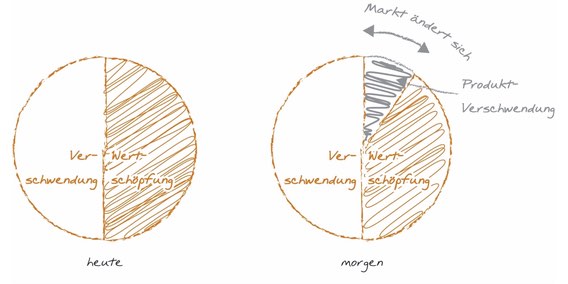Agility has its roots in lean. But what is lean anyway? And what is the difference between lean and agility? We provide a brief answer here.
What does agility have to do with lean?
If we have to put it very simply, we can sum it up as follows:
Agility = Lean + Innovation + Work 4.0
What is Lean?
Lean means creating the greatest possible value for customers while avoiding waste and utilizing the skills of employees. According to Womack and Jones, lean is based on five core principles:
- Define value from the customer's perspective
- Identify the value stream
- Get the work flowing (Flow)
- Create the pull of work (Pull)
- Always strive for perfection (Kaizen)
Lean is in agile methods
These five principles can also be found in agility. Scrum a sprint review and a sprint retrospective, because this is how the pursuit of perfection is implemented. The sprint review serves to perfect the product, and the sprint retrospective serves to perfect the way we work. And thinking from the customer's perspective may sound like a platitude, but when customers ask us for feedback on their business plans, the product ideas are very often based on "what we can build" - and not on "what the customer wants". The fact that we start requirements in Scrum with "As a <customer> I want ..." is no coincidence. In principle, Scrum is an implementation of the lean principles for development tasks, or rather: for plannable work.
Agility adds the speed of innovation to lean
Agility has a special focus on innovation. Since we have been measuring innovation cycles, they have halved every two years. This is why agility includes the speed of innovation or the "deliver early and regularly" paradigm. In principle, this is also about avoiding waste, i.e. delivering products or services that miss the market. This is why all agile methods start with a circle and a focus on "delivering quickly". In Scrum, this is the sprint, and in Lean Startup, the cycle with the minimum viable product.

Agility relies on Work 4.0
Good products, inspiring service and motivated employees support each other. That is why "Empowered and self-organized teams" is one of the agile principles. In addition to the fact that everyone is better off this way, the principle also has very tangible economic reasons.
Many companies are still - more than a hundred years after Taylor - organized according to the principles of scientific management. This is based on Taylor's premise of separating creative from mechanical work. But it is precisely this mechanical work that is being automated today under the heading of "digitalization" - what remains is creative work. This needs different principles than those of scientific management in order to function well. That's why we organize companies better today according to the agile principles.
In addition, Taylorist organizations may be very efficient in the "now", but they are too slow when it comes to innovation. Or as Stephen Elop, the former CEO of Nokia, put it during Nokia's decline: They "are cranking out a device much faster than ... the time that it takes us to polish a PowerPoint presentation." Empowered and self-organized teams can deliver innovations at a significantly higher speed than a Tayloristic organization with one-way communication and centralized decision-making powers.

Write a comment